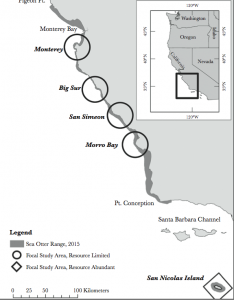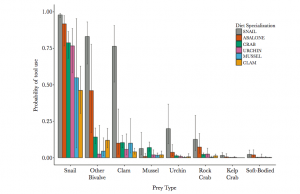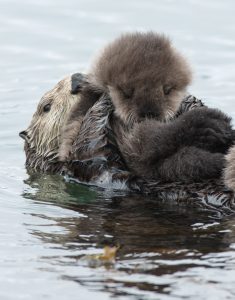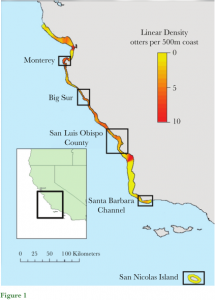Food abundance, prey morphology and diet specialization influence individual sea otter tool use
By Molly Rickles, SRC Intern
In this study, Fuji looked into how ecological factors impact sea otter’s tool use. Sea otters are known to be near shore foragers that carry food on the surface, and have been observed to use tools to eat their prey. In many other species, tool use has been found to be a response to a lack of food, since the tools allow the animal to eat less preferential species easier. This means that individuals that are found at sites with limited food will have a more specialized diet. Researchers wanted to see if this would be the same with sea otters.
In this study, sea otters were tagged from 2000-2014 in five study areas across California. The individuals were tagged using a plastic cattle tag on their hind flippers as well as with an implanted VHF radio transmitter. The animals were observed as foraging for food when they were found to be repeatedly diving underwater and returning to the surface. The results of these foraging dives provided the data, which included the dive outcome, prey identification, time spent handling prey and if tools were used. Once data was collected, groups were classified based on the most prevalent prey item, which included: Abalone, crab, mussel, clam, urchin and snail. In addition, AIC statistics were made for each model, and then compared to select the best-supported model based on the data.

This figure shows the various sites where sea otters were tagged and researched. Even though many of the sites are close together, each site had different prey species present which presented different scenarios for the sea otters. (Source: Fujii, J. A., Ralls, K., & Tinker, M. T. (2017). Food abundance, prey morphology, and diet specialization influence individual sea otter tool use. Behavioral Ecology. doi:10.1093/beheco/arx011)
It was found that crab was the most common prey item. In addition, in sites where food was limited, sea otters were found to have more diversity in prey. Results showed that adult females were the most common tool-users, and that snails were the most common prey eaten with tools. Sea otters who most often ate snails were found to be more likely to use tools to eat other types of prey, since they were accustomed to using tools to eat snails. This also went the other way, since species that ate prey that did not require tools were less likely to use tools with more difficult to eat species.

This graph shows the predicted probabilities of tool use among the different food groups consumed by sea otters. Sea otters that eat snails have the greatest chance of using tools to consume snails as well as other prey. (Source: Fujii, J. A., Ralls, K., & Tinker, M. T. (2017). Food abundance, prey morphology, and diet specialization influence individual sea otter tool use. Behavioral Ecology. doi:10.1093/beheco/arx011)
These results show that dietary differences among the individual sea otters played a role in tool use, especially when food resources declined. Researchers observed that older sea otters used tools more frequently, showing that tool use requires time and energy spent learning to be successful. In addition, pups raised by females who used tools were commonly seen using the same tools and eating the same prey, suggesting that mothers teach it, which could be an area for future research. This study proved both the necessity hypothesis and the opportunity hypothesis, showing that tool use increases when prey is limited and that tool use improves prey capture, making it a beneficial skill.
Work Cited
Fujii, J. A., Ralls, K., & Tinker, M. T. (2017). Food abundance, prey morphology, and diet specialization influence individual sea otter tool use. Behavioral Ecology. doi:10.1093/beheco/arx011



